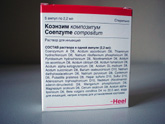Coenzyme compositum ampullen (Homeopathic remedies Heel)
Injection

Composition: 100 ml contains: Vitamin C D6 5 ml; Vitamin B1 D6, Vitamin B2 D6, Vitamin B6 D6, 1 ml; Nicotins Cureamid D6 3 ml; Acidum cis-aconiticum D8, Acidum citricum D8, Acidum fumaricum D8, Acidum a-ketoglutaricum D8, Acidum DL-malicum D8, Acidum succinicum D8, Baryum oxalsuccinicum D10, Natrium oxalaceticum D6, Natrium pyruvicum D8, Cystein D6, Pulsatilla D6, Hepar sulphuris D10, Sulfur D10, ATP (Adenosintriphosphat) D10, Nicotinamid-adenin-dinucleotid D8, Manganum phosphoricum D6, Magnesium oroticum D6, Cerium oxalicum D8, Coenzym A D8, a-Lipons Cure D6, Beta vulgaris rubra D4 1 ml.
Indications: Stimulation or normalization of activity of blocked enzyme systems in degenerative diseases (cell phase).
Dosage: Usually 1 ampoule subcutaneously, intramuscularly, intradermally 1-3 times a week.
Form of release and packing: The package contains 5, 10, 50 or 100 ampoules of 2.2 ml.
Brief description of indications for the use of individual components of the formulation: Vitamin C Coenzyme (regulation of oxidation-reduction processes, especially in the decay of the basic substance of connective tissue). Vitamin B1 Coenzyme (oxidative decarboxylation). Vitamin B2 Coenzyme (flavoproteins and oxidation-reduction processes). Vitamin B6 Coenzyme (transaminases, dehydratases, desulfhydrazides, decarboxylases). Nicotinamid Coenzyme (dehydratase). Acidum cis-aconiticum Regulator of the Krebs cycle and oxidation-reduction processes. Weakening of protective mechanisms. Acidum citricum Bleeding gums. Deteriorating diseases. In addition: the regulator of the Krebs cycle. Premature aging, arteriosclerosis, in particular cerebrosclerosis. Physical exhaustion. Acidum fumaricum Regulator of the Krebs cycle and oxidation-reduction processes. Conditions of exhaustion. Acidum a-ketoglutaricum A regulator of the Krebs cycle and oxidation-reduction processes. State of frustration. Acidum DL-malicum The regulator of the Krebs cycle and redox processes. Regulator of detoxification processes. Acidum succinicum Hay rhinitis. In addition: the regulator of the Krebs cycle. The state of exhaustion, "leaden heaviness." Barium oxalsuccinicum Regulator of the Krebs cycle and redox processes. Endocrine disorders, circulatory disorders of the extremities. Natrium oxalaceticum The regulator of the Krebs cycle and oxidation-reduction processes. Reduction of protective mechanisms. Natrium pyruvicum The regulator of the Krebs cycle and redox processes. Regulator of detoxification processes. Cystein Sulfhydryl factor of the oxidation-reduction potential. Retoxic disorders. Side effects of drugs. Pulsatilla Skin disorders . Varicose veins. Inflammatory respiratory disease; Tendency to catarrhal diseases. Inflammatory and other diseases of the digestive system, female genital organs, bladder (including violation of its emptying). Rheumatic diseases. Sleep disorders, neuropsychiatric disorders. Hepar sulfuris Inflammatory and pustular diseases of skin and mucous membranes. Predisposition to disorders of the lymphatic system. Nervousness. Sulfur Various, especially chronic skin disorders. Acute chronic diseases of the respiratory and urogenital tracts, gastrointestinal tract. Hepatobiliary disorders. Diseases of the cardiovascular system, including violations of blood pressure. Rheumatic diseases. Sleep disorders. Nervous disorders. States of weakness. Disorders of the mood and behavioral disorders. In addition: constitutional, reactionary and perestroika, but similarly enhancing cellular immunity. Adenosintriphosphat Maintain energy cells (Krebs cycle, etc.), especially when treating side effects of drugs. Nicotinamid-adenin-dinucleotid Biocatalyst. Stimulator of oxidative processes. Manganum phosphoricum Depletion states with anemia. Replenishment of the body's need for microelements, especially the Krebs cycle. Magnesiumorotat Replenishment of the body's need for microelements, especially for the improvement of liver function. Cerium oxalicum Vomiting. Whooping cough. In addition: all conditions associated with hypoxia or caused by it. Coenzym A Coenzyme for transacetylation processes. A-Lipon-saure Coenzyme for hydroxylation processes necessary for the decomposition of pyruvic acid (oxidative decarboxylation) Beta vulgaris rubra Reactivation of tissue respiration (including infectious diseases). Chronic catarrh.
This drug promotes the action of vitamin and other factors on the citric acid cycle as initiators (inducers) of enzyme systems. Its homeopathic components (promoting enzyme regeneration), trace elements and intermediate catalysts have a spacious but not excessively healthy therapeutic effect on the blocked or non-activated enzyme systems. Because of this, this drug is shown for all phases of the disease to the right of the biological barrier (in the phases of impregnation, degeneration and neoplasms). It is appointed as an intermediate for various neoplasms in conjunction with Ubichinon compositum, Thyreoidea compositum, Hepar compositum, Glyoxal compositum (the final preparation is applied no more than a couple of times). With any lesion of enzyme systems, it is recommended to prescribe Coenzyme compositum, Ubichinon compositum, Galium-Heel, Engystol N and Traumeel S. These drugs have helped cure many patients. Coenzyme compositum is able to prevent the processes of progressive vicariation (thus, cancer) and create the prerequisites for the reactivation of blocked respiratory chain enzymes.
With subcutaneous and intradermal injections of this preparation containing vitamins, a small amount of flour can be observed.


Comments
When commenting on, remember that the content and tone of your message can hurt the feelings of real people, show respect and tolerance to your interlocutors even if you do not share their opinion, your behavior in the conditions of freedom of expression and anonymity provided by the Internet, changes Not only virtual, but also the real world. All comments are hidden from the index, spam is controlled.